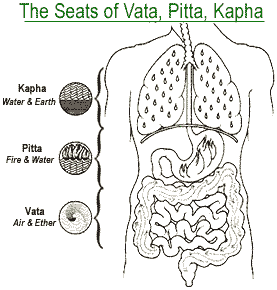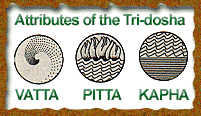| | Ayurveda is a holistic healing science which comprises of two words, Ayu and Veda. Ayu means life and Veda means knowledge or science. So the literal meaning of the word Ayurveda is the science of life. Ayurveda is a science dealing not only with treatment of some diseases but is a complete way of life. Ayurveda aims at making a happy, healthy and peaceful society. The two most important aims of Ayurveda are:
+ To maintain the health of healthy people
+ To cure the diseases of sick people A Person is seen in Ayurveda as a unique individual made up of five primary elements.
These elements are ether (space), air, fire,water and earth.
Just as in nature, we too have these five elements in us. When any of these elements are imbalanced in the environment , they will in turn have an influence on us. The foods we eat and the weather are just two examples of the influence of these elements . While we are a composite of these five primary elements, certain elements are seen to have an ability to combine to create various physiological functions.
The elements combine with Ether and Air in dominence to form what is known in Ayurveda as Vata Dosha. Vata governs the principle of movement and therefore can be seen as the force which directs nerve impulses, circulation, respiration and elemination etc.,
The elements with Fire and Water in dominence combine to form the Pitta Dosha . The Pitta Dosha is responsible for the process of transformation or metabolism. The transformation of foods into nutrients that our bodies can assimilate is an example of a Pitta function. Pitta is also responsible for metabolism in the organ and tissue systems as well as cellular metabolism.
Finally, it is predominantly the water and earth elements which combine to form the Kapha Dosha. Kapha is responsible for growth, adding structure unit by unit. It also offers protection , for example, in form of the cerebral-spinal fluid,which protects the brain and spinal column. The mucousal lining of the stomach is another example of the function of Kapha Dosha protecting the tissues.
| |
We are all made up of unique proportions of Vata,Pitta and Kapha. These ratios of the Doshas vary in each individual and because of this Ayurveda sees each person as a special mixture that accounts for our diversity.
Ayurveda gives us a model to look at each individual as a unique makeup of the three doshas and to thereby design treatment protocols that specifically address a persons health challenges. When any of the doshas become accumulated, Ayurveda will suggest specific lifestyle and nutritional guidelines to assist the individual in reducing the dosha that has become excessive. Also herbal medicines will be suggested , to cure the imbalance and the disease.
Understanding this main principle of Ayurveda , it offers us an explanation as to why one person responds differently to a treatment or diet than another and why persons with the same disease might yet require different treatments and medications. | 
|
| | | |
| | Other important basic principles of Ayurveda which are briefly mentioned here are:- Dhatus- These are the basic tissues which maintain and nourish the body. They are seven in number namely- rasa(chyle), raktha(blood), mamsa(muscles),meda(fatty tissue), asthi(bone), majja(marrow) and sukla(reprodutive tissue). Proper amount of each dhatu and their balanced function is very important for good health.
- Mala- These are the waste materials produced as a result of various metabolic activities in the body. They are mainly urine, feaces, sweat etc. Proper elimination of the malas is equally important for good health. Accumulation of malas causes many diseases in the body.
- Srotas- These are different types of channels which are responsible for transportation of food, dhatus, malas and doshas. Proper functioning of srotas is necessary for transporting different materials to the site of their requirement. Blockage of srotas causes many diseases.
- Agni- These are different types of enzymes responsible for digestion and transforming one material to another.
All these factors should function in a proper balance for good health. They are inter-related and are directly or indirectly responsible for maintaining equilibrium of the tridoshas. Balance and Harmony of the Three Doshas
When the three Doshas are well harmonised and function in a balanced manner, it results in good nourishment and well-being of the individual . But when there is imbalance or disharmony within or between them, it will result in elemental imbalance , leading to various kinds of ailments.
The Ayurvedic concept of physical health revolves round these three Doshas and its primary purpose is to help maintain them in a balanced state and thus to prevent disease.This humoral theory is not unique to the ancient Indian Medicine : The Yin and Yang theory in chinese medicine and the Hippocratic theory of four humours in Greek medicine are also very similar.
| |
| | The Qualities of the Three Doshas
The three Doshas possess qualities and their increase or decrease in the system depends upon the similar or antagonistic qualities of everything ingested.
Vata is : dry, cold, light, mobile, clear, rough, subtle
Pitta is : slightly oily, hot, intense, light, fluid,free flowing, foul smelling.
Kapha is: oily, cold, heavy, stable, viscid, smooth, soft
Both Vata and Pitta are light and only Kapha is heavy.
Both Vata and Kapha are cold and only Pitta is hot.
Both Pitta and Kapha are moist and oily and only Vata is dry.
| |
Anything dry almost always increases Vata , anything hot increases Pitta and anything heavy , Kapha.
Puffed rice is dry, cold light and rough - overindulgence in puffed rice therefore is likely to increase Vata in the overindulger.
Mustard oil is oily , hot , intense , fluid , strong-smelling and liquid and increases Pitta in the consumer.
Yoghurt , which , being creamy, cold, heavy, viscid, smooth and soft , is the very image of Kapha , adds to the body's Kapha when eaten.
All Five elemets , as expressed through Vata, Pitta and Kapha , are essential to life, working together to create health or produce disease. No one dosha can produce or sustain life - all three must work together , each in its own way.
|  | |


No comments:
Post a Comment